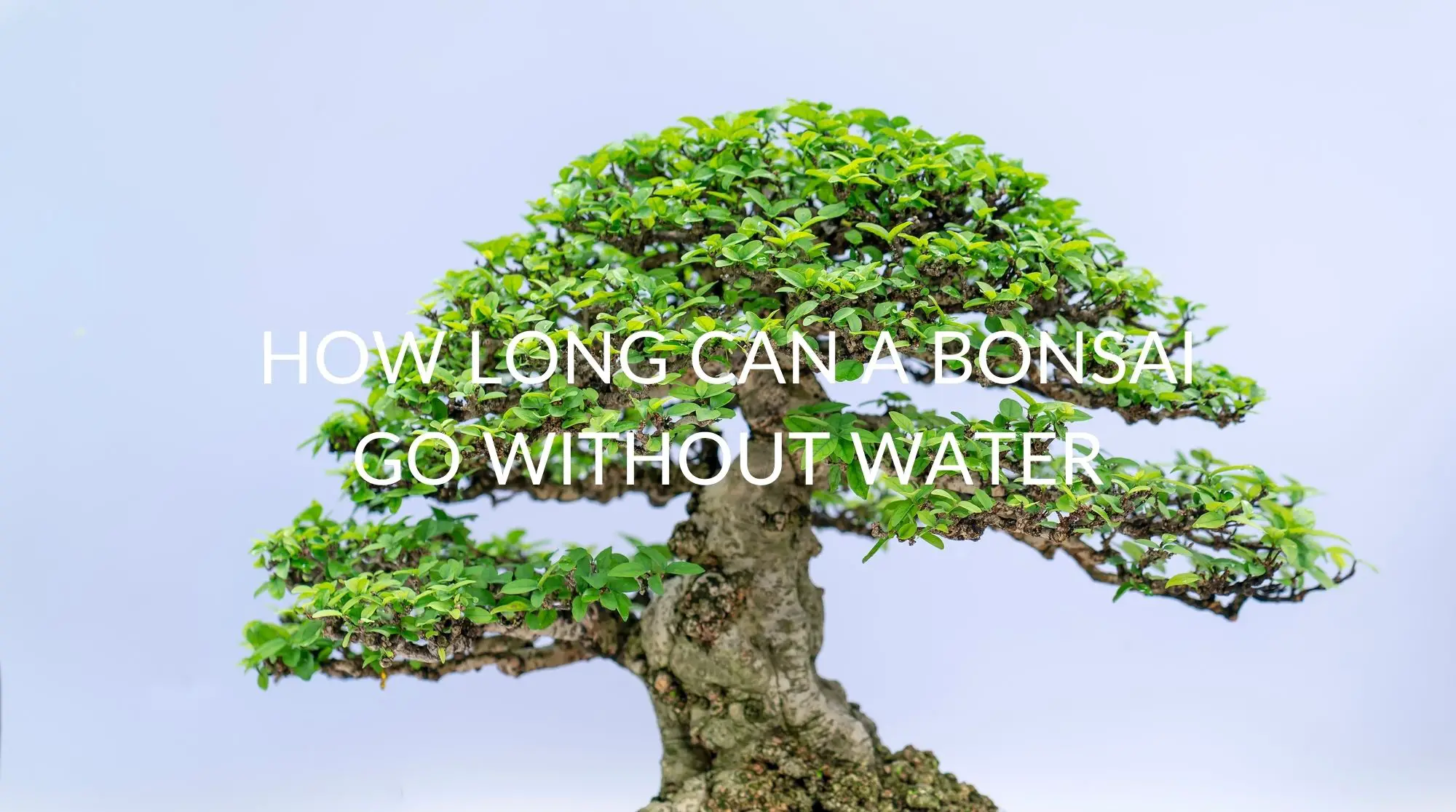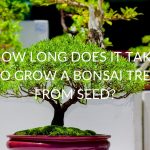It depends on the species of tree and its growing conditions. Some Bonsai may need to be watered more than once a day, while others can go 3-5 days between watering.
It is crucial to the health of your Bonsai tree that you water it adequately. Overwatering and underwatering are some of the most common reasons why Bonsai trees do not survive.
Part of the difficulty with watering Bonsai is figuring out how frequently they need water. It doesn’t make sense to water Bonsai on a schedule because a tree may need more or less water during certain times of the year or in certain conditions.
Bonsai isn’t like other houseplants that can be watered once a week all year round or that tolerate partial watering every so often.
Bonsai need to be watered thoroughly each time they are watered and allowed to drain. Keep reading for some tips on how to make sure your Bonsai is getting the water it needs.
How Long Can My Bonsai Go Between Waterings?
Bonsai are grown in very small pots with very little soil, which means their pots don’t retain a lot of water. Without this water in reserve, the trees will die if they don’t get watered frequently.
Bonsai growing in very small pots, bright sun, long summer days, dry climates, or outdoors might need to be watered as much as 2-3 times per day.
Bonsai growing in shadier conditions or wet outdoor conditions may only need to be watered every few days.
The only way to know how frequently to water your tree is to do a soil test. Feel the top of the soil for dryness. If the soil feels dry up to a centimeter down, the tree needs water.
If the tree is completely dried out, you will need to soak it immediately.
Keep in mind it is also possible to overwater your Bonsai, so stick to the soil test, and you shouldn’t have any problems.
How Often Should A Bonsai Be Watered To Stay Healthy?
If you notice brown or yellow leaves on your tree, or your foliage has black spots or black edges, that may be a sign that you are overwatering your tree. If foliage turns brown and drops off, this may also be a sign that you need to adjust your watering regimen.
A tree that is not watered enough will dry out very quickly and die. Severely underwatered trees cannot be revived.
Conversely, a tree that is overwatered may develop root rot–a condition where the roots cannot absorb water and nutrients.
The only way to determine how much water your tree needs is to monitor the soil closely and only water the tree when the top of the soil is dry.
Signs That A Bonsai Needs Water
If you have a new Bonsai tree, you will need to watch it closely to determine how much water it needs. Watch for these signs of underwatering to help you gauge your tree’s water needs.
If you notice any of these signs, the next step is to test the soil and see how damp it is. Don’t just water your tree if you see one of these signs because that might lead to overwatering. The point is to get to know your tree and what it needs.
Soil is Dry One Centimeter Below Surface
The best way to determine if your Bonsai needs water is to put your finger in the soil to test for dampness. You can also use a chopstick to use as a visual measure. If the soil is dry all the way to a centimeter (at most an inch) below the surface, water your tree.
If the soil is only dry at the surface, the tree is not yet ready to be watered. Check it again in a few hours or at the end of the day.
Drying Leaf Tips on Bonsai
One of the first signs you will see is drying leaves. Some of the leaves or the tips will become crispy and eventually fall off your tree.
It is normal for all trees to lose leaves, but if your tree has many crispy leaves, this is probably due to underwatering.
If you have a deciduous tree, it may drop its leaves in the fall naturally. Make sure you know the species of your tree and what is normal in terms of leaf drop.
Drooping Leaves on Bonsai
Some deciduous trees will show noticeable drooping leaves when the tree needs to be watered. When you first notice the droop, the tree will need to be watered. Ideally, you should water the tree frequently enough that the leaves never droop.
Bonsai Dropping Leaves
If a tree that hasn’t undergone other stress such as moving or repotting suddenly drops a lot of leaves, this may mean it is underwatered. If you notice a lot of leaf drops, check the soil for dampness.
If the soil is too damp, make sure you let it dry out, so you don’t overwater your tree.
Yellow Foliage on Bonsai
Evergreens such as Juniper, Spruce, and Pine might show yellow foliage if they are underwatered. As soon as you notice yellow foliage, test the soil for dampness. You may need to adjust your watering routine.
Pot Feels Too Light
As you get more familiar with your tree, you may start to gain a sense of when it needs water based on the weight of the pot. If you have a small tree in a small pot, you will be able to lift it to determine when it is dry.
As you get started with a new tree, give it a try. Lift the tree just after soaking and then again when the top of the soil is dry and it needs water. As you get accustomed to your tree, you may begin to sense when the soil needs water.
How To Water Your Bonsai
The way to water Bonsai is to soak the soil completely each time you water it and then let it dry. With Bonsai, you won’t be giving the tree little amounts of water to just dampen the soil. Here are some tips for the best ways to water a Bonsai.
Use a Fine Nozzle
Bonsai are grown in pots without a lot of extra space at the surface. You may have roots above the surface as well if they are part of the style of your tree.
Furthermore, you may have loose soil at the surface of your pot. In order to avoid losing soil when you water your tree, you may want to invest in a watering can with a narrow nozzle, so you can control the flow of water and gently water your tree.
It is possible to buy a Bonsai watering can with a narrow nozzle and long spout. Really any watering can that allows you to control the water will do. If you go to a garden store, try out a few and figure out which one feels best to you.
Soak Soil Completely
If you are watering with a watering can, make sure you soak the entire surface of the soil evenly. Don’t just water in the trunk. The entire root system of the tree needs to be evenly soaked. You will know you have watered it enough when water runs out of the drainage holes in your pot.
You may want to soak the tree fully, let it drain, and then soak it again.
Don’t let your tree sit in water as it drains, though, as this will lead to root rot. Either water your tree outdoors or in a sink–someplace where water can drain fully.
Submerge in Water
If you don’t want to water with a watering can, you can also submerge the entire pot in water. Watch to make sure all the air bubbles have risen to the surface. Remove from the water and let fully drain.
You may have to repeat this process until no more air bubbles come to the surface.
Make Sure Your Bonsai Can Drain!
Your Bonsai tree absolutely requires a pot with drainage holes. A small pot may have only one drainage hole, whereas others will require more than one.
Bonsai pots with feet that lift them off the ground will typically allow the tree to drain better, though you can use any pot as long as water can drain out.
Do Not Leave Your Bonsai Sitting in a Dish of Water
Keep in mind, however, that all this drainage means you need to keep a close eye on your tree so it isn’t underwatered. If you repot your tree into a pot with large drainage holes, its watering requirements may change as well.
Use Bonsai Soil
Most common Bonsai Trees such as Ficus, Juniper, Jade, Japanese Maple, and Chinese Elm grow perfectly well in premixed Bonsai soil. This soil is coarse and sandy and supports adequate drainage.
If you have another species of tree, you may need to use a different mix of soil.
At the very least, make sure your tree is growing in sandy soil (not potting soil). If you have a new tree, check out the soil. You may want to repot your tree into fresh Bonsai soil if the current soil is dense or has a lot of clay matter.
Use Rainwater or Tap Water
Rainwater is best for Bonsai because it isn’t treated with chemicals (and it saves water!), but most Bonsai will do fine with regular tap water. If you start to notice marks on the leaves where your tree was watered, you may need to switch to distilled or rainwater.
Water at Any Time of Day
The best time of day to water your Bonsai is when it needs water. Some experts recommend watering at night, so if that works for you and your tree, then go for it. If not, you can water a Bonsai at any time of day. The most important thing is that it receives water when it is dry.
If your tree is sitting in the sun in very hot soil, you may want to avoid watering it with cold water that could shock it. Let the water sit out for a bit and warm up.
Is It Possible To Save An Underwatered Bonsai?
Yes, but time is of the essence. As soon as you notice anything wrong or off about your tree, look into the cause. The earlier you correct issues with Bonsai, the more likely your tree will survive.
If your tree is completely dried out, submerge it in water immediately to increase its chances of survival. You may need to do this several times or until you don’t observe any air bubbles rising to the surface.
Some experts recommend wrapping the tree and pot in clear plastic to retain moisture. Make sure to keep an eye on your tree, so it doesn’t mold.
How Do You Water A Bonsai When You Go On Vacation?
Get a Bonsai Sitter
If you have a friend or neighbor who you trust to water your tree, this can be a good option. You will need to know roughly how often the tree needs to be watered, however, and the sitter will need to water it correctly.
Some Bonsai nurseries will “board” your tree and care for it while you are away.
Bury Your Pots
Some experts recommend burying your pots in soil up to ½ inch deep, in the shade. The trees will be able to tolerate the low light for a short amount of time, and the soil will keep the pots moist.
Bonsai Irrigation Systems
There are automated systems available for watering Bonsai, though they are costly and might only make sense if you are leaving your Bonsai frequently.
You can also try capillary matting, which fits in the bottom of your pot and through the drainage holes, and wicks water up into the soil from a water source. You can ask at a garden store about capillary matting materials.
FAQ
Can I Leave My Bonsai Without Water For A Week?
It depends on how large your Bonsai pot is and how quickly it dries out. Most Bonsai will not tolerate an entire week without water.
How Long Can A Juniper Bonsai Go Without Water?
Juniper and other evergreens (such as Pines) do not tolerate wet soil. A Juniper may be able to go slightly longer than other Bonsai but must still be watered when the top of the soil is dry. Juniper Bonsais are typically grown outdoors, so they will need more water than an indoor Bonsai, especially in the summer months.
Juniper also enjoys misting.
How Long Can A Ficus Bonsai Go Without Water?
Ficus Bonsais are good for beginners because they can tolerate more underwatering or overwatering than many other species. They must still be watered when the soil is dry. You can also mist a Ficus a few times a week.
Conclusion
The best way to determine how often to water your Bonsai is to monitor its soil very closely. With practice, you will know when (and how) to water your tree.








